Giuseppe Acerbi examines the theme of the Boreal Paradise in the Hindu tradition, framing it in the doctrine of cosmic cycles and highlighting its correspondences with the Hesiodic and Platonic tradition, finally analyzing the symbolisms that are found in the artistic representations of this locus amoenus.
di Joseph Acerbi
originally published on On the slopes of Mount Meru, author's blog
and reposted by The Lost Image
cover: Mandala del Monte Meru
The near eastern conception of the Heaven on earth as the original seat of the first human couple it is also reflected in the Middle East, both in Iran and in India. In India, however, something else can also be found in this regard, which does not correspond to the narrow vision of the Abrahamic traditions, at least in their exoteric aspects. In short, a kind of erotic multiplication of the theme takes place in myth and iconography, eg. in the famous Khajurāho architectural complex. The couples become innumerable and orgiastically mingle with each other, in a way that is almost transfused into the original divine couple, according to an archetypal model that transcends and enhances them to the extreme degree of being in a supernatural garden of pleasures. In practice they reflect, on a spatial level poetically immersed in the world of nature, although formally stylized, the primordial spiritual dimension of communion with the animal and vegetable world; in the symbol described as a state of magnificent physical bliss, however, not separated from an entirely interior acquisition of goods. The abundance of pleasures thus takes on the role of vehicle of heavenly and earthly gifts at the same time.
The geographical cradle of the Arian strain
In the last two centuries, Europeans have worked hard to trace the alleged original seat of the "Aryan race", a claim that as such could not be satisfied in the slightest; since it did not correspond to anything true on the real cosmographical plane, the hidden purpose of this theory being below that of justifying European colonialism in Asia and elsewhere. This does not mean that only Europeans have been subjected to it. Apart from Eurocentrism, unfortunately this mistake was also committed by oriental scholars, especially Indians; which have suffered the negative influences of the cd. Ārya Samāj, lit. 'Assembly of the Arî', an apparently indigenous movement (it was founded in 1875 by D. Saraswati and partly influenced even the great Tilak), but strongly influenced by the Anglo-Saxon imperial mentality through the Theosophical Society, it is no coincidence that it settled in India in those years. And as such devoted to racial prejudice.
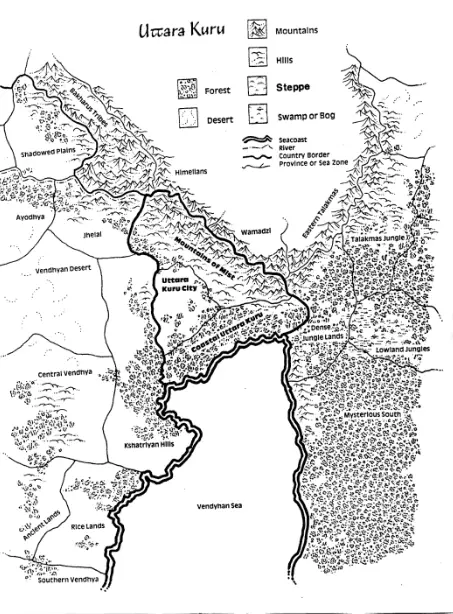
Manvantara, Yuga and the Avataric Cycle
Here, however, we do not want to deal with the Aryan argument in relation to nineteenth-century European racism, but in reference toUttarā Dry (skt. Uttarādry) (1). Uttara Kuru is, according to Hindu cosmography, the fifth manifestation of land emerged over the entire Great Aeon (Manvantara)and an Manvantara it is a human period in its totality, if we want an entire Adamic cycle; since as happens in Iranism also in Hinduism a multiplicity of 7 human cycles is conceived, corresponding to 7 Earths, represented by 7 concentric rings around the Merupārvata. These 7 cycles are then repeated in reverse to form a Kalpa, made of 14 Manvantara. Each Great Aeon in turn can be divided into 10 Avataric Cycles, i.e. in 10 Yuga of 6.480 years each; what was defined in classical Greco-Roman culture Mâgnus Annus Platônis, with related Great Months, evidently each 540 years old (2).
The Avataric Cycle was also known to Greeks and Romans, probably they had learned it from the "Chaldeans", according to what can be deduced from certain passages of Plato that we have commented elsewhere (3) as well as through Virgilian IV Eclogue (4). Every single Yuga is determined by the yoga (conjunction) of the 7 visible planets, the last of which occurred in the sky on May 3, 2000 (5). This at the end of the X Avataric Period, although the world has not - up to now at least - absolutely become aware of it except in a subconscious form. The great changes that seem to be on the agenda in politics and in the surrounding nature can certainly be interpreted in this light, even if one must be very careful not to fall into illusions.
It is on this doctrinal basis that the Arian problem must in any case be set up, exactly as they did in their time Hesiod and Plato with the Heroes (even in that case a human generation and not a race), rather than on the historicistic prejudice manifested by a certain European Right or, on the contrary, on the anti-historicistic prejudice of the opposing political party. The subdivision of the Manvantara it can however be alternatively quinary or quaternary (6). The first includes the same periodizations as the denaria subdivision, but grouped two by two; so that each doubled cycle - of more than 12.960 years - will be related only to the 5 Great Directions (the Cardinal Points + the Boreal Polar Center, that is to say the Arctic) (7), excluding from the list the Intermediate Points (NE, SE, SW, NW + the Southern Polar Center, i.e. Antarctica) (8).
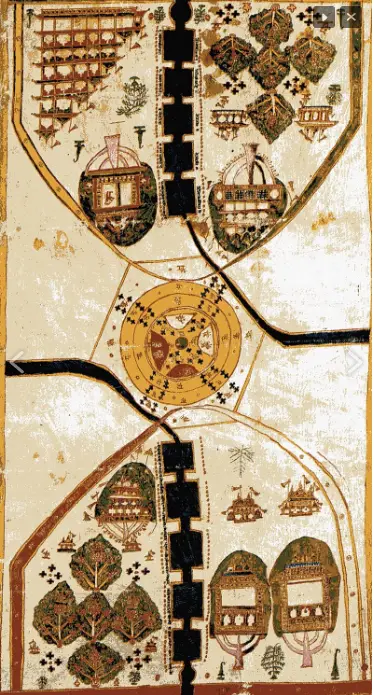
The second, on the other hand, is characterized by dharmic symbolism or by a regressive development of time, such that in each cycle - from the Golden Age to the Iron Age - the Yuga they are grouped decreasingly according to the known formula 4 + 3-2 + 1 = 10; what is called, geometrically, squaring the circle. It is a question of a hermetic problem widespread in all evidence both in the Indo-Iranian world and in the Greek-Latin one; and that it is present, albeit in a less overt way, even in the Celtic-German-Slavic culture. The denominations change here and there, but the substance remains roughly the same (9).
A similar cosmogonic myth, no matter what Eliade thought, also peeps out into the Semito-Hamitic world, although more hidden than the Japhetic world. Indeed, this last term indirectly introduces the discourse on the Boreal Paradise. Since the 5 Great Ecumens (Pancamahādvīpa) gradually attending the Jambudvīpa (o Dvīpa della Melarosa), the continental extension characteristic of the VII Manvantara (although some use the term more narrowly, as a synonym forBhārat i.e. of the Indian territory), Uttara Kuru is the fifth in order of time. Coming after theIlāvṛta (Arctic), the Secretiveāla (to E), the Bhāratavarṣa (to S), the Bhadrāśva (to the West) and being located at N (10).
A North, however, quite distinct from the Arctic, although by transposition one ecumene refers to the other and refers to a given direction simply as the nerve center of cultural expansion in a given epoch. Now, it is not of Arî that we should speak in relation to the Boreal (Northern) Paradise, but rather of Japhetis, a biblical term much more convenient than the one now quoted and unjustly rejected by today's scholars (11). Since, Plato teaches us once again (12), the demigods or heroes - to which the Arîs seem to be related from an etymological point of view (13) - belonged to the Bronze Age.

Therefore, according to the Platonic doctrine, chronologically they would belong to a period of 12.960 years prior to the mythical Iron Age (14). Since the latter is the Age of Men, not of Heroes. Before the great philosopher of the sixth century. BC the poet Hesiod (15) he placed them, indeed a little inordinately albeit effectively, even further back; that is, halfway between the Bronze Age and the Iron Age, but in the quinary scheme he adopted it would have been better to speak of III and V Era, so as to associate the Age of Heroes with the IV. Or he would introduce the symbolism of a fifth metal, as did Iranian cosmology.
In precise chronological terms, the Platonic reference is to a cycle that goes from 17.440 to 4.480 BC, the Hesiodic one to one extending from 23.920 to 10.960 BC In other words, Plato places the Heroes between the Advent of Atlantis and the Deluge of Deucalion; otherwise, Hesiod places them entirely within what we might call in terms of gypsy cosmology "Cycle of the Red Race". The Red Race according to the Gypsy culture (16), not for nothing of Indian origin, was to be considered a mixed race (17). What is moreover proven today by ethno-anthropology, which hypothesizes the arrival of two strains that crossed over on American soil, one paleo-Asian from the Arctic and the other Austronesian of Antarctic origin. (A third ethnic branch would even come from the Pacific.)
It did not declare Greek mythology, see eg. Heracles, that Hereōes od Hemitheoí Were they children of gods entertaining with humans? Jewish traditions further clarified the concept, asserting albeit obscurely (Gen.- VI. 4) that the descendants of the gods were meant by heroic people "Sons of God crossed with the daughters of men".
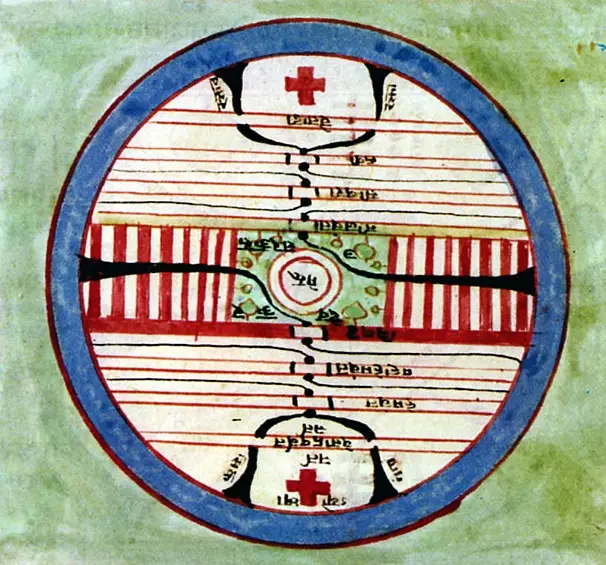
In short, according to what is generally interpreted, sethiti and cainites. Despite the incongruity of the XNUMXth century Hellenic poet, given that he adopted the cyclical terms of the Quaternary subdivision (Gold, Silver, Bronze and Iron) while actually inserting the number of human generations into his cosmogony instead of the quinary one ( Gods, Superior Demons, Inferior Demons, Heroes and Men), the cyclical collocation of the Heroes or Arî that he has adopted appears correct; a position that we would dare to define late-paleolithic, interpreting the problem in a palethnological key, the Indo-Europeans - a bogus denomination invented by convention in contemporary times, starting from linguistic studies and never unanimously accepted except in the twentieth century - being nothing but the last form assumed by the biblical Jafeti after the various crossings of the Western and Eastern Arian lineages with different racial elements (pre-Arî).
It must also be taken into account that in the same heroic lineage understood Platonically, that is to say placed 6.480 years later, Semites and Hamites should be counted, albeit with a distinction as a percentage. In practice, all the descendants of the legendary Noah, whom the Greeks called Heracles and the Indians Kṛṣṇa (the latter two have also been identified with each other since ancient times), mixed differently in Eurasian and North African territory with what remained in the XNUMXth Era of the previous races: the White, the Yellow and the Black; the only ones considered by the Gypsies as well as they never hybridized, unlike the Red and Brown, the penultimate and the last (18).
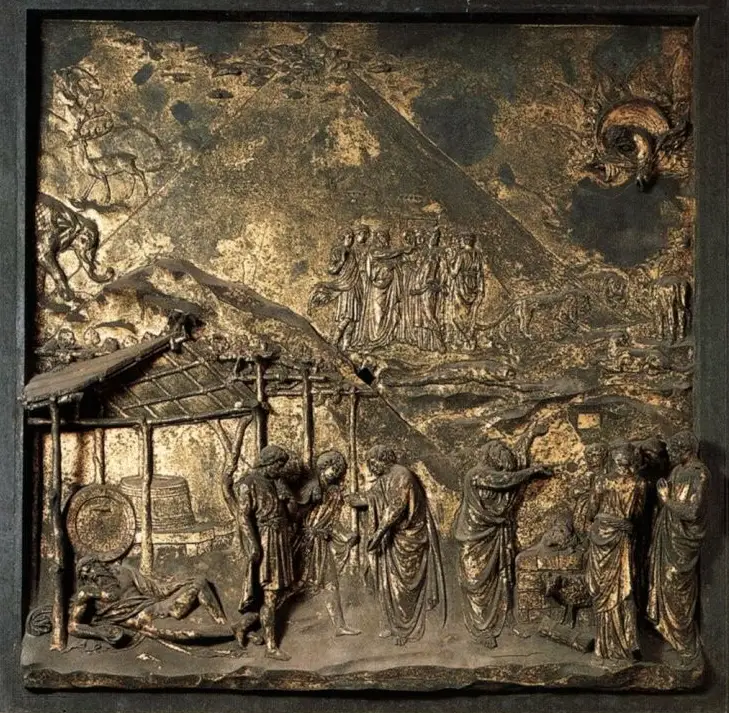
According to what he indirectly proves the original symbolism of the colors of the 3 Magi( Power in the royal sense) (19). The figure of Noah no less than those of Heracles and of Kṛṣṇa on the other hand it has two biblical aspects, one anti-diluvian and the other post-diluvian; in Greek mythology, however, the character of Heracles shows some Olympic-Paleolithic references and others heroic-Mesolithic (20) however, already noted by Herodotus (21). Likewise in India the IX avāra, Kṛṣṇa-Jagannātha, the post-diluvian - or Mesolithic if you prefer - stunt double of the VIII appears visibly, Kṛṣṇa-Gopāla.
So if we mean the Uttarākura some Indian texts (of which Bussagli found an echo in the Ottorokórrai by the Greek author Amometus) (22), from Mahābhārat, as the Heracleo-Noaic-Krishnaite descendants taken as a whole it is clear that these must be taken as the metonymy of the populations located roughly north of the equator in the current contingencies of the globe; or, meaning them in a chronological sense, roughly the Eurasian inhabitants (with the exception of the Paleoasians, which are something else, and other stocks coming from the south hybridized with the Yellow Race) of the last 12.960 years. In short, those belonging to the so-called V Era, dominated according to the gypsies by the Brown Race - the denomination derives from the Hebrew, that is from the meaning of the name Pine, which is the first to open the last era - and according to the Greeks it gives Anthropoi. Their paradise (which is also ours, of us current men), clearly a distant echo of the originally Hyperborean one in a still prehistoric world evidently waned gradually to give way to the atrocities of Kaliyuga, it appears more a chimera than an actual reality.
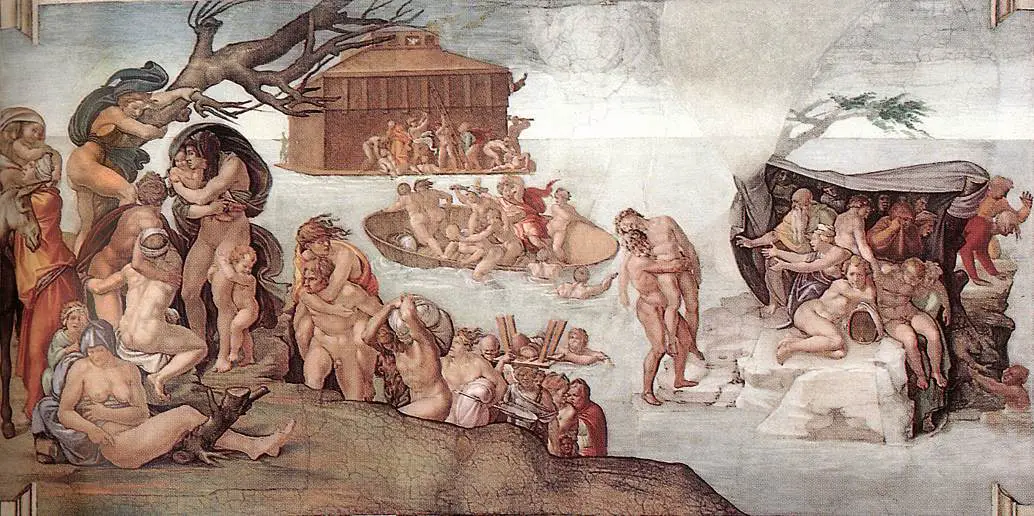
In fact, this is not how the much vaunted one appears Thoulē (23) of the Greeks and Romans? In any case, the aforementioned populations would not fall within the Hesiodic Heroes at all, but would be instead to be identified on the basis of Plato for one half to the Heroes and for the other half to the Men; in short, what in the palethnological language we define roughly Mesolithic and Neolithic. Taken together, the two categories, it should be noted, simply correspond to the Men of the Hesiodic quinary scheme. The Hesiodic quinary scheme is used in India mainly from Mahābhārat, while the Platonic quaternary scheme - sometimes Hesiod also uses it and vice versa Plato does with the quinary - often recurs in Pureāṇa; it being understood that the two solutions may appear reversed, here and there, even in India. Since these are applications of certain mythic rules, not distinct forms of thought. The quaternary scheme is proportional, the quinary one is equal.
Clarified this essential point and referring to other studies (24) for a broader discussion of the subject, which necessarily implies ideas diverging from ours and less adherent to a discussion of a strictly cosmographic nature, we are going to examine below the findings of the myth in the literary and artistic fields. Always remembering that the Arian prejudice - bad faith aside - is partly justified, but only in part, by the actual confusion that has occurred in recent times betweenairyānot goēĵo (25) - the definition is proper to Iranian sacred texts, although there is still a region called in India today Hariyānā - and the Items ('Fence' = Garden) origin, which Hindus know as Ilāvṛta. He saw suprâ.

We are convinced on our part that theAiryan em Vaeso (this is the correct pronunciation, glue -is- very short of the gen.pl. and the -z- dolce) is more or less equivalent to Uttara Kuru, in short, to the Northern Ecumene and not to the Arctic, regardless of the part of the Arctic to which it is alluded. And that the Items (26) on the other hand, refer to Pairi-daeza (The Paradeśa Indian), i.e. the Hyperborid (27), although the same thing appears in the Iranian text. This is due to the fact that the overlap between the two lands, chronologically placed at the antipodes of manvantara, has happened consistently in Iran as well as in India. So much so that it is difficult to distinguish in this regard when there are no other additional references that make them two separate ecumens, as well as placed at the beginning and at the end of the Great Aeon. With the inevitable consequence, as time passes, of fading into one another.
Lately we have become convinced that even on a geographical level, not only chronological and cosmographic, there must have been a clear distinction between the two lands. Since it is not plausible that the Paradise Earth of Adamic origins has sunk a few hundred meters below the sea level of the current Arctic and then partially returned to the surface, this being valid exclusively, if anything, for the land called Varāhī (28). If our thesis is correct then it means that no less than the 2 celestial poles the same terrestrial poles in the span of many millennia must have moved within their respective polar circles from one given point to another (currently the two geographic poles are located one in the Arctic Ocean, in correspondence with the Land of Baffin, and the other in the middle of Antarctica), or that the loss of the Hyperboride occurred due to climatic factors due to the displacement of the inclination of the earth's axis, traditional data pushing in that direction (29).
And what was the Arî Region then? Scandinavia or Greenland (lit. 'Green Land') (30), or another area of Eurasia or North America (31)? We are personally convinced that she was in the North America, perhaps in Greenland or some land adjacent to it. I Celtic myths. And that then she had moved to a new land, this time in Northern Europe (32). According to the denominations, Britain could be pointed out as the second radiation center (33), not by chance identified atavallon, the 'Land of Apples'. As for the passage from one side of the Atlantic to the other, it is not certain that this was done in a single solution, via Iceland. A passage further south could also have taken place, via Azzorre, according to what is taught by the Bible: see the legend of the landing on Mount Ararat, in the middle of the flood, which implies a previous entry into the Mediterranean. From there, a reunion in Europe of the two ethnic strands of cross-Atlantic origin would then take place.
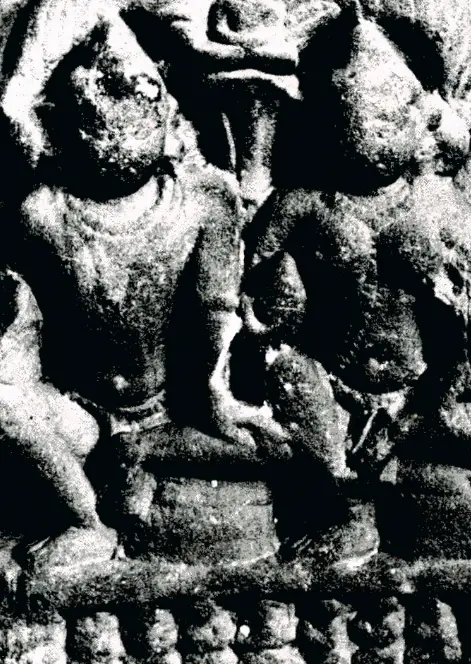
The Nordic Paradise in literature and art
Literary references to the theme can be found in the Agrawala saying (34) in Brāhmaṇa (Ait.B.- viii. 14 and 23), but not in the See, as well as in the epic-Puranic literature (Har.P.- vii, PdP- iii). Even the Buddhist tradition has embraced the concept, from Dīgha Nikāya (That.- xxxiii. 4) al Mahāvānija Jātaka; and, similarly, that jaina (Adi Pur.- iii). The 2 fundamental elements characterizing theUttarādry I am the Couple (or Mithuna, that the jaina they call Yugala) as well as the Tree of Kalpa (Kalpavṛkṣa o Kalpadruma). Indeed, they are such emblems that stand out in artistic representations (35). It is only in the art jaina however that Uttara Kuru is illustrated on a cartographic level. However, this is not a representation with authentic geographic evidence, but rather an ideal cosmographic representation (36), tending to contrast the aforementioned ecumene with Devakuru, the Region of the Gods (37).
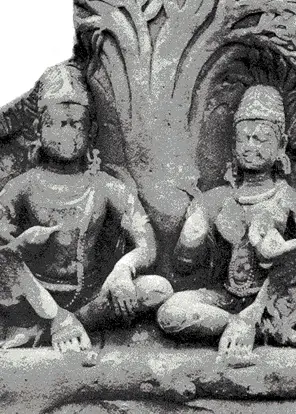
According to Agrawala, the Northern Paradise has ended up becoming a paradigm of reference in Indian mythology no less than other parallel emblems of bliss and abundance such as the Stuffed Jar (Even thoughṇAghata), the Cornucopia (Nidhiśṛṇga), the Cow of Desires (Kamadhenu) or the Thought Gem (Cintamani). Each of these marks constitutes a precious reference for the Hindu to that mysterious one quid interior having the property, in fact, of satisfying every desire. The quid, of course, it is given by what Western alchemists believe is the point of arrival of the cd. Great Work.
Now, however, for the sake of greater clarity, it will be necessary to explain the emblems mentioned one by one, including the heavenly ones at the beginning and at the end of the discourse. The Kalpa it is the largest unit of time in the Indian cosmogony. In 1 kalpas 14 are enclosed manvantara and each kalpa therefore indicates a cycle of manifestation in itself. The Kalpavṛkṣa therefore has the same function as the Iambicūvṛkṣa, albeit over a longer period of time. About the PureṇAghata it is soon said. It is but the Indian equivalent of the neo-Persian Oracular Cup of Hoursśīd, or of the Christ Holy Grail.

Vice versa the Nidhiśṛṇga (lit. 'Horn of the Treasury') is often associated with Kubera and acts as Horn of Plenty, full of buds, while essentially having the same prerogatives as our Cornucopia, which instead is full of fruit. Kamadhenu (lit. 'Cow of Desire'), first born from the stirring of the Ocean of Milk (the Arctic Ocean), is alternatively called Surabhī, NAndeanī o Ilā (vilā) and has counterparts in both Egypt and Northern Europe. The white cow Shilluk eg, the Stutleys teach us (38), is generated by the Nile, while the Norse Auohumla it also arises from the melting of massive masses of ice. Instead the Cintamani is only there Philosopher's Stone.
In conclusion, the Mithuna in the Northern Land it is poetically imagined living in one atemporal condition of perpetual bliss and unchanged prosperity, free from the needs and pains afflicting common human nature. In this idyllic vision the members of the various heavenly couples they are described in the fulfillment of a life never far from that of one's own businesses, chasing a parallel fate of painless death.
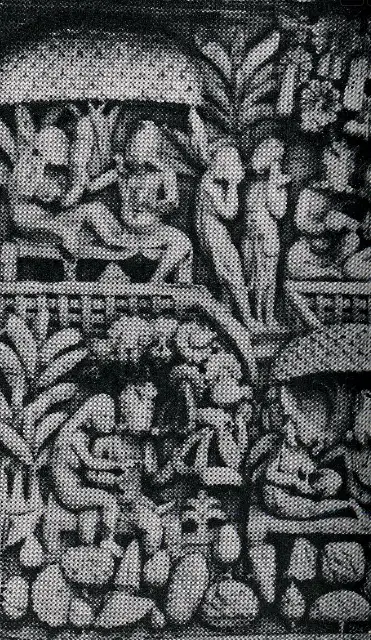
Almost an ecstatic rapture, in line with the intimate rapture of the senses in which they spent their existence. In 1972 the prof. Knock him (Professor of History of the Art of India and Asia C. at the 'Sapienza' in Rome), on the occasion of the publication of his fine essay on eros (39), thus introduced the topic:
"An ancient Indian legend, which has remained alive through the centuries, describes the beings that inhabit the" northern continent ", the Uttarakuru of imaginative traditional cosmologies, and imagines them as human beings of extraordinary beauty, born without pain, in pairs ( male and female), destined for a very rapid development. Each couple, lost in mutual contemplation, expert in all the pleasures and games of love, lives ten thousand years of flourishing youth. Born together, the two die at the same time, held in a supreme embrace and the gigantic garudas, magical birds that feed on snakes and elephants, transport their bodies to the mountain, which is the axis of the world, without any trace or memory of their life, of their appearance, of the flame of love that remains. it has fed and enthralled them for millennia. "
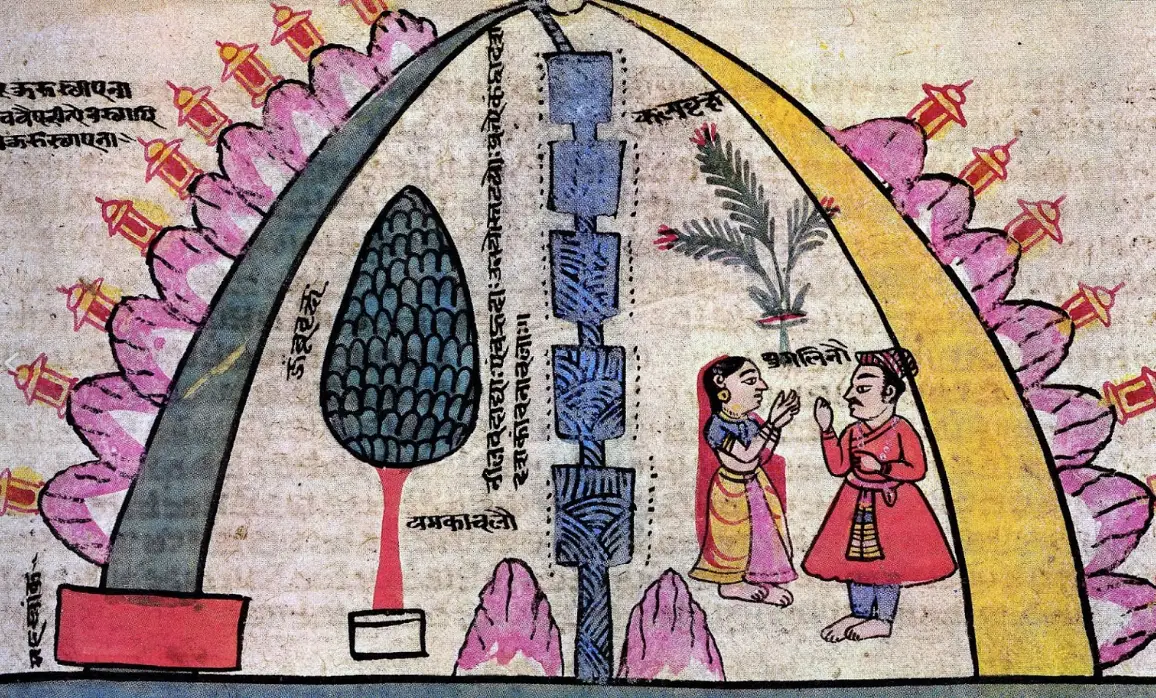
Note:
1) For the etymology of this expression see on the one hand Gr.chṓra ('land, territory'), S.kur-u / kurā (id.); on the other, Eng.ut-t-er ('external'), compar. of an archaic prep.* ut ('out', hence the English mod. o-ut), upper.ut-most o ut-ter-most ('extreme'). See with comp.out-er (outermost '), sup.outmost o out-er-most ('much more external'). Correspondingly in Greek we have, in an almost analogous sense, the comp.m.hýst-eros and the sup.m.hýst-atos; likewise, in Sanskrit, comp.m.ut-t-ar-a (f.–ī) and the sup.m.ut-tam-a (f.–î). The reference particle in this case is ud, a preposition that is erroneously assimilated to Eng.up('up') and in rare cases it appears alone. Ud instead it is equivalent to zend uz, got.ūt, aat.ūz, nat.from / apart from. And it means 'out, give'. It should be noted that the Greek voices cited indicate a "secondary in space and time" according to the Greek-Italian Vocabulary of DG Gemoll (ed. R. Sandron, Milan-Palermo 1922, svhýsteros, p.831, col.b), transl. of the Greek-German Dictionary of the same author; while the Sanskrit ones, figuratively speaking, mean respectively 'of the north' and of the extreme north '. Therefore, from all this we deduce that theUttarā Dry it was not the Hyperborean Land, the ecumene for which India has reserved the special denomination of Ilāvṛta ('Hidden Land'), but the Northern Land; whether America or Eurasia is not clear, but we believe the former.
2) G.Acerbi, Kālacakra. The Cosmic Wheel- Univ. "Ca'Foscari", Venice 1985, P.II, Chap.V, pp. 364.5.
3) See G.Acerbi, The 'Caste' according to Plato. Analysis of parallels in the Indo-European world- Convivium (Sear), A.IV, N ° 12 (Jan.-Mar.), Scandiano 1993, P.II, Chap.V, pp. 364-5.
4) In the short introductory study to the IV Ecloga L.Canali (Virgil, Bucolic-Rizzoli, Milan 1978, p.93) interprets the passage of Buc.- iv. 4-55 ss as an evident reference to the new cycle of 10 great years announced by the Cumaean Sibyl, each great year being characterized by a metal.
5) C. Berlitz, 1999, the year of the Apocalypse- Mondadori, Milan 1984 (ed.or. Doomsday 1999 AD.), p.49, fig. no.
6) In the quaternary graphic scheme typical of the European annual calendar, only 4 Directions appear instead of 5, unless the center is also considered; so that it will be the Winter Solstice, that is the N (in relation to the Nadir), to represent the North Pole. While the Summer Solstice, that is the S (in relation to the Zènit), will represent the South Pole. See in this regard R.Guénon, Traditional forms and cosmic cycles- Mediterranee, Rome 1974, passim; and. or. Traditional shapes and cosmic cycles Gallimard, Paris 1970). This is why the Spring Equinox, in relation to the E, will include not only the E; but also the 2 intermediate directions, the NE and the SE. Likewise, the Autumn Equinox, in relation to the O, will include not only the O, but also the SW and the NO. If instead we applied to theCaturyuga the quaternary zodiacal scheme, as also Alighieri does (Par.- xxvi, 138-42), we should pair Spring and therefore E with the Golden Age, Summer and S with the Silver Age, Autumn and O with the Bronze Age , Winter and N to the Iron Age. In the first case the application is directional-annual, in the second rhythmic-seasonal.
7) Today the Arctic coincides with Siberia for those who stubbornly understand the northern geographic pole as fixed, but if we accept the idea that the pole - or rather the earth's crust - is mobile it is evident that in the past the Arctic circle may have been found in another region: Scandinavia, Baffin Land or Alaska. As determined studies, on the other hand, have pointed out (G. Hancock, Footprints of the Gods- Corbaccio, Milan 1996; ed.or. Fingerprints of the Gods, 1995). In this regard, two other writings cited by the author in the PV of the book just indicated can be consulted: CH Hapgood,The flow of the earth's crust- Einaudi, Turin 1965; Id., The Path of the Pole, Chilton B., N. York 1970.
8) The same discourse referred to in previous n. it is true for Antarctica, where, however, due to the prevalence of submerged lands, polar shifts are naturally more difficult to ascertain.
9) Unfortunately, it is this correct subdivision, based on the 5 cardinal points (traditionally there are 5, not 4, since the Arctic Pole is also to be considered) and the intermediate ones that our traditionalism has lacked since the time of F. d'Olivet unlike the authentic one (Indian, for example); so that a wrong approach was derived from the start, even though it was based on great personalities of great value such as Guénon and Evola. In this, however, the underlying hand of a certain counter-traditional organization ruled by Saint-Yves must be seen. Speaking of traditional things, however, one cannot ignore the authors cited, it is right to reserve them the honor they deserve; however at the same time their errors must be corrected, because this falls within the very point of view of their teachings.
10) To demonstrate this, in a map reported by DC Sircar in his Cosmography and Geography in Early Indian Literature - and re-creates in C. Blacker & M.Loewe, Ancient cosmologies- Ubaldini, Rome 1978 (ed.or. Ancient Cosmologies- G.Allen & Unwin- London 1975), Chap. 5, p.105, n.9 - Mount Meru is placed in the center of a circle surrounded by the mountain range of endāloka and illustrating the situation of the Earth on a cosmographic level. At the top, that is, in the North, there is theUttarādry. If it had been the same as the Meru, the latter would not have been placed in the middle of the 4 Dvīpa. The authors, not realizing the difference now indicated, mistakenly identify the Uttarādry (it is said howeverUttarākura) with the Hyperboreans. The mistake of confusing the North with the Arctic Pole was made by practically everyone, even by Evola and Guénon (including their respective schools), albeit more by one than the other. In the mature years Guénon warned the Europeans of their Eurocentrism for the truth, but in the general chaos - and perhaps for a karmic question given the tribute he offered in his youth to the OTO (through the Papus-Reuss branch) or rather to the 'Otr according to someone (M. Introvigne, The magician's hat- Sugarco, Varese 1990, P.II, Chap.7, p.276 and Chap.6, pp. 237-8), no less than Evola and others - he too ended up partially falling into the traps of the Synarchy. Though the thought of him has yet to be fully explored. Prof. Introvigne, it is understood all too well, tries to discredit him by making him pass for a spiritualist who later converted to Islam; with all that this entails in terms of spiritual seriousness, evidently. This is not a good reason, on the part of others, to deny the necessary steps which led the French master to his subsequent positions. Even the various scriptures of the prophets do not deny the underworld.
11) The biblical Japheth is equivalent to the Greek titan 'Iapétos, son of Uranus and father of Atlas as well as of Prometheus and Epimetheus. According to some (A. Morelli, Gods and myths. Encyclopedia of Universal Mythology- ELI, Turin?, svGiapéto, pp. 256, col.a- 257, col.b) “Iapetus is perhaps to be identified with Japhet, son of Noah. In support of this hypothesis there is not only the similarity of the names. Prometheus, son of Iapetus, is considered the progenitor of the Greek lineage. Well, one of Japheth's sons is Javan, and Javan is the term by which the Greeks, that is, the Ionians, were designated by the Semites. And that's not enough; the book of Genesis (10, 5) states: "From them (i.e. by the sons of Javan) came the peoples who scattered around the islands of people". Those islands can only be the Greek archipelago ”. Morelli is right, especially if he takes into account that Deucalion was born from Prometheus and from these Hellenes. In another version of the myth Deucalion is the son of Minos, double of Prometheus. The Hebrew name of Japheth it also refers to the Indian one of Prajāpati, lett. the Sir (Pati) of the progeny (Prajā), silver deity posterior to Cousinṇa. The sf pra-jā it is in fact formed in Sanskrit by the pref. pra- (Lat.pre-, bigpro-) and by the pass.–Jā ('born'). Therefore we deduce that the presiding deity at Kaliyuga, Prajāpati precisely (old orionic-solar titan recycled in recent times no less than Prometheus, who in his previous capacity was equivalent to Cronus), served as an archetypal human ancestor after the death of Kṛṣṇa at the end of Dvāparayuga. Not for nothing is it replaced in Indian texts, sometimes, by Manu; not the Manu original, golden, but rather the prototype of the Manuṣa ('Men') in a chthonic sense. This explains the equivalence of Manu with Minos, Cousinṇa with Uranus, Prajāpati with Iapetus, Kṛṣṇa (or Noah, if you like) with Atlas; and of the Orionic Hellenian cerviform (see etymology) with the Orionic hunter Nebrod, the biblical figure to whom the legendary construction of the Babelica Tower is attributed. In other words, the creation of a sub-earthly infirm (palpel in Hebrew, Semerano informs us, it means 'to confuse'), according to what the occult iconography of the XVI Tarot Blade teaches us.
12) Crat.- xv /c-xvi / e.
13) The gr.Hereōs ('hero') is visibly related from the philological point of view to S.Ārya ('noble, respectable'). The Herōes it is no coincidence that they are put by Plato in relation to the commercial and artisanal class (including farmers), using the factor of fertility (éros) as a guiding principle; well, this is also just gods Ārya. If it is true that the sm arya, written with glue a short, means 'merchant' in Sanskrit. The fact that even the Heroes used weapons or were kings, princes did not prove their real belonging to the aristocracy, so as the soldiers of the ancient and modern world do not belong for the same reason to the heroic generation even if they have proclaimed themselves emperors. Unless there are special merits, which are always possible even outside a consolidated social category or in times subsequent to those of the cyclical expansion of a given class. As Greece teaches. See in this regard Ac.,art. cit., pp. 17-8.
14) Which obviously has nothing to do with the archaeological age in this way called.
15) Hês., Op.- vv. 156-73.
16) See G.Acerbi, I Pancajāna, the 'Five Races of the Gypsies' and the 'Seeds' of the Tarot- Algiza, (N ° 12), Chiavari 1999, p.16.
17) The concept of race among the Greeks and Latins was absent, so much so that there are no Greek or Latin terms to indicate it. The term ghšénos (Lat.genus), connected to Lat.gens (skt.jāna, jāta / i), actually designates the lineage or lineage. The word 'race' is in fact considered by etymologists of uncertain origin, although it seems to derive from the a.frc.haraz('horse breeding'). Modern French uses races,but still maintains the smharas, with the meaning of 'race, herd; stallion depot, equine breeding establishment. ' It is probably an onomatopoeic name referring to the riding of horses, but it generally connotes a repetitive act. In this sense, cf. the following two verbs: the frc.exhaust('to tire') and the gr.arassō ('knock while making noise').
18) Ibid.
19) This interpretation of ours is not far-fetched, it has a traditional meaning regardless of the color of the skin of the Magi. So much so that we find an identical symbolic distribution in a non-Christian context, a Nordic fairy tale collected and adapted by O. Wilde in his collection of fairy tales published in 1891, A house of pomegranates. The story, entitled The Fisherman and his Soul, conceives a journey of the Soul once separated from the Fisherman towards the 4 Directions of the World. The first stop is in the East, where the Mirror of Wisdom originates, where everything that exists is reflected except the one who looks. Returning to the Fisherman, the Soul asks him to re-enter him, who had abandoned her in order to dedicate himself to a dream of love for a Siren. But the Fisherman denies her the return, since "Love is better than Wisdom". The second stage is in the South, where the Soul finds the Ring of Wealth. Same ceremonial on the return, but once again the Fisherman rejects it, since "Love is better than Wealth". The other two stages, theoretically to the West and to the North, appear to be suppressed in what is left of the original story, or rather confusedly reduced to one. But there is a last attempt by the Soul to return with the blackmail of pleasure and once again the Fisherman tells her no. Since "Love is better than Pleasure". Until the Siren dies, causing the death of the Fisherman too, forced a few moments before, however, to leave a hole for his Soul to return one thing with him. Now, if we mean Love in relation to the Supreme Direction, the fifth, which transcends the others (in other words the Polar Direction), it is clear that in the context Love plays the part of Myrrh, the Wisdom of Incense and the Wealth of Gold. In a scripted version of the aforementioned narrative, made in 2000 and presented in vain to some Milanese and Roman film house for the making of a 35 mm film, we have modified the plot to the point of recreating the 2 missing Directions with the relative Ecumens (Western and Nordic, i.e. a fantastic Atlantis and historical Great Britain), the whole being obviously in relation to the 5 Elements. But it is clear that the most important are the first 3, not surprisingly the only ones present in the fairy tale. They are therefore equivalent to the 3 Magi, symbolically embodying the psychic prerogatives of the 3 fundamental Races: the White, the Yellow, the Black.
20) See C. Bonnet Xella, The great labors of Hercules- Archeo (IX, N ° 1 [107], gen. '94), De Agostini-Rizzoli, Rome 1994, pp. 58-71; also, G. Acerbi, The Fisher King and the Golden Fish ...- Atanor, Rome 2013 (next), Chapter VI, passim.
21) Ibid., p.72. This fact gives the impression that in reality the Demigods, contrary to what Hesiod and Plato told us, were distinct from the Heroes. In short, the latter were closer to men, chronologically and temperamentally; while the others indicated the direct descendants, on Atlantean or American soil, if you prefer, of those whom the Jewish tradition defines as Sethiti and Cainites. The heroes would be, in other words, the survivors of the Flood.
22) Other Greek writers, such as Ptolemy, have actually spoken of it; still others, such as Megasthenes, referred according to Lassen to the Hyperboreans but meant the Ottorakórrai (LBG Tilak, The Arctic Home…- Tilak Bros., Poona 1971, ed.or. 1903; Chapter XI, pp. 319-20).
23) Lett.'terra ': Lat.tellūs (id.); writetala = 'base, surface, bottom, sole of the foot, sole of the shoe' etālā/ tallikā = 'fragrant earth'. Others (J.Evola, Revolt against the modern world- Mediterraneee, Rome 1969, 1934st edition 2; P.II, Chap. 232, p.XNUMX) derives the term from Tonalan ('Land of the Sun'), whence the contraz. in Tullan, mythical homeland of the Toltecs. How can the aspirate be explained, in this way, in Gr.Thoúlē? Although we are convinced that it is indeed a single original etymology, alluding on one side to the sky or the sun and on the other to the earth, we point out that aspiration sometimes differentiates the second meaning from the first in Indo-European languages: cf. eg. the scr.kāla ('time' in the celestial sense), lat.arc. caelus ('sky' in the atmospheric sense), with khala / kuru / ku ('earth'), gr.chNow/ gē (id.). Thus, we observe, the initial consonant of the words ctonî varies from guttural (k-, kh-, gh-) to the dental (t-, th-, d). The gr.chtṓn ('earth') summarizes them all, since it unites the guttural to the dental, even though the medial liquid (-r-, -l-) has become nasalized. Instead in Lat.humus ('land, soil'), usually paired to it by the lawyer.flameí...(from *chamá = id., where the -m- It corresponds to -n-), only the aspirated persisted.
24) RC Jain,The Most Ancient Aryan Society- IBR, Delhi 1964, Chapter III ff.
25) This term was understood as "cradle of the Arî" (Til., op. cit., p. 295), meaning vaēĵo as a term related to S.bīja ('seed'); but it would be more correct philologically in our opinion to connect it with S.varṣa/varta ('land, continent'). In short, theairyānǝm goesēĵo is none other than theĀryavarta, in all the meanings in which the expression can be understood; although the first word in Iranian is a noun declined in the plural genitive and in Sanskrit an attributive apposition, in the manner of English. See on the topic G.Acerbi, The myth of the Gokarṇa and the dramatic battle between Perséo and Medúsa- On the slopes of Meru (17-01-13), on this one blog, pp. 11-2, 8.
26) See in this regard the scr.Īśearly, item where the first part (Īś/ Īśa) of the compound name it alludes to the Supreme Spirit or to the Lord in a personal sense; while the suff.-Vara, appearing of uncertain origin, it could conceal an obliterated cosmographic reference to the aforementioned “Enclosure”. Especially since the base * var-, indicating concealment, can be found in the second part of the term Ilā-varta, terminological variant of Ilā-vṛyour. The meaning of the expression is the same as in Lat.Latium, from vr.lateo = 'to be hidden', that is of '(Earth) Hidden'. The scr.ilā ('earth', in the wooded sense) is comparable, more precisely, to the gr.Ýlē ('forest').
27) What Guénon asserts (op. cit, Chap. II n.num., P.31) or that the pref.yper it was added by the Greeks in a time - the Classical Age - in which the meaning of attr was no longer known.Borš-éa-s ('boreal'), which he connects to the root from which the name of the boar comes (S.var-āhas), it's incorrect; if anything, the opposite is true, namely that it is contemporary European traditionalism that has lost the original distinction between the Hyperborean Cycle and the Northern Cycle. Nonetheless, this distinction appears every now and then in both Guenonian and Evolved cosmography, without the two authors drawing the necessary consequences from it. What the French author adds immediately afterwards regarding the Cycle of the Boar and the Bear shows that he confused the assumptions of the Druidic tradition with those of the Brahmanic tradition. After all, the name Varāhī it does not allude so much to the 'Hyperborean Land' as to the 'Eastern Land'. The whole question is actually more complex than what is said now in the footnote, it should be treated specifically as a topic in itself. And if we simplify it, we do it exclusively for a reason of space.
28) Confused with it but in reality a duplicate of the Eastern Ecumene, the Bhadrāśit goes, called by the Polynesian natives Hawaii; so much so that in the contemporary world this name has ended up becoming, mutatis mutandis, the name of an exotic fruit juice from the Pacific.
29) On the magnificently Evola theme (op. cit., Chap. 3, p.235) cites a decisive passage (Li-tze- v), mentioning the Giant Kung Kung that "breaks the pillar of heaven".
30) Evola (ibid., p.237) observes in this regard: "Greenland, as the name seems to say, seems to have had a rich vegetation until the time of the Goths and was not yet hit by freezing." This is extremely interesting, regardless of whether the author confuses the Arctic with the North. Which is understandable, on the other hand, if it is true that it also occurred in traditional texts and in oral transmission data.
31) See in this regard what is specified in Ac., art. cit., n.12. We will try to answer this question shortly in a book that we intend to prepare, entitled The Avatār and the slippage of the Poles, of which we will shortly publish there in advance in the form of a separate article the final chapter, already provisionally drawn up.
32) Others too (F. Vinci, On the trail of Eden- Hera, No. 109, Feb. '09, passim), although they do not distinguish between a post-Paradise Atlantic land (the true Eden, that is, theEren according to Dupuis, literally the 'Land of the Arî') and the Earthly Paradise, place the last homeland - we would say “the Last Thule” - before historical times in Northern Europe; and not in Central Asia, where the importation of horses seems relatively recent.
33) Evola (cit., p.239, n.18) mentions another passage, by Hecateus of Abdera (XNUMXth century BC), where it is established that Britain had been inhabited by the Hyperboreans. These people, of subarctic origin, have been identified with the Protocelts; a Celtic branch evidently closely similar if not identical to the proto-Germanic one, made up of fishermen and hunters, which seems to have preceded the more evolved Celtic branch (Hamito-Druidic) of Mediterranean origin. This second branch was instead dedicated to sheep farming and agriculture, according to what the underwater archeology has recently proved through the finds of the doggerland, the strip of land that once joined Britain to Europe before the last flood. And it would have reached the area at the beginning of the Neolithic, or c. 6.000 years ago, then merging with the local population.
34) PK. Agrawala, Mithuna. The Male-Female Symbol In Indian Art and Thought- Munshiram M., N. Delhi 1983, Chap. 3, pp. 15-6.
35) Ibid., ill. 24, 26, 43, 44.
36) C. Caillat, & R. Kumar, Jain Cosmology- Ravi Kumar / Lilakala AG, Basel-Paris-N. Delhi 1981, p. 159, pl. 83.
37) Ibid., p. 157, pl. 82.
38) M. & J. Stutley, Dictionary of Hinduism- Ubaldini, Rome 1980 (ed.or. A Dictionary of Hinduism- Routledge & Kegan P., London 1977), sv: K.ĀMADHENU, pp. 204-col.b-205, col.a.
39) M.Bussagli, Indian Eros- Bulzoni, Rome 1972, Intr., P.11.

A comment on "Uttara Kuru, the Boreal Paradise in Indian cosmography and art"